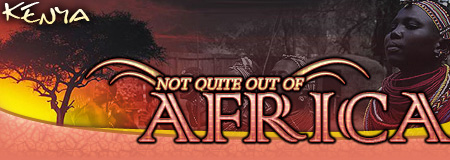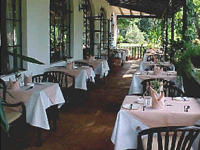|

Visiting the Kenya of "Out of Africa"
by Mary Ann Anderson
I had a farm in Africa, at the foot of the Ngong Hills . . .
You
probably know by now this lyrical line opens Isak
Dinisen's autobiographical "Out of Africa,"
a novel first published in 1937 that is regarded
as one of the greatest love stories of all time.
But the book is not so much about a love between
a man and a woman, as many would believe, rather
between a woman and the country she came to embrace
as her own, at least for a while.
In the novel, Dinisen, better known as Karen Blixen, splendidly narrates the years from 1914 until 1931 she spent as an independent woman living on Bogani, a coffee plantation in Kenya during the British colonialization of East Africa.
The 1985 film version of "Out of Africa," starring an appropriately cast Meryl Streep as the strong-willed Blixen and Robert Redford as her audacious lover, Denys Finch Hatton, won the Oscar for "Best Picture," which catapulted renewed interest in the book and especially Kenya itself.
After the film debuted, women couldn't get enough of Redford lovingly washing Streep's hair-and even her ironclad nerve at shooting the charging lion. Men couldn't get enough of wanting to live the adventurous life of the mysterious big-game hunter so memorably portrayed by Redford. And of course, tourism to Kenya skyrocketed.
Although it has been decades since Blixen called Bogani home, it still stands today just on the outskirts of Nairobi in a neighborhood now called "Karen" in honor of Blixen. Bogani, which is indeed located at the foot of Ngong Hills, embodies the intense drama that is Kenya. The word Ngong literarily means "knuckles," and this is a place aptly named: Legend holds that the hills surrounding where Blixen's coffee plantation is where God rested His hand after He made the world.
It is here, in the shadows of God's "hand," that Blixen lived. She was a striking yet gutsy woman who could have been the original steel magnolia, had she been born and bred in the South.
The plantation, now a national museum, has been carefully restored with original and reproduction furniture to harmonize with the architecture and décor of Blixen's time. Her writing desk remains, as does a replica gramophone of the music-loving Finch-Hatton. In keeping with the true tone of early 20th century East Africa, there is still no electricity to the home; its rooms are lit only by the Kenyan sun.
 |
Just down the road from Bogani is the Swedo House, an original hunting lodge and farmhouse built for the Swedo-African Coffee Company and now a part of the Karen Blixen Coffee Garden Restaurant and Cottages owned by Colorado-born Bonnie Dunbar. Blixen spent much of her time there, and her brother, Thomas Dinisen, resided in the home during his trips to Africa.
Sometimes you stumble upon a remarkable character who seemingly has leapt straight from the pages of a romance novel.
One such character is Dr. Dunbar, a brainy blonde who scooped up the Swedo House from a gentleman named Frank Sutton before it could be razed and turned into a shopping center.
"After Karen left Kenya in 1931, the property was basically residential until Frank Suttton bought it in the 1970s for use as a restaurant," intones Dr. Dunbar. "It was just a little shack essentially when I bought it."
The feisty doctor who saved the historic Swedo House from being destroyed forever has a resume that includes biologist, zoologist, scientist, biochemist, and even race horse owner. And she has been likened by her friends as the "new Karen Blixen" for her fortitude in giving up her secure life in the United States-like Blixen did of Denmark-for one of an innkeeper and restaurant owner in a country that is still considered primarily Third World.
Dunbar has her hand in everything from hospitals to conservation to elephant contraception, and she has worked with famed anthropologist Richard Leakey on several projects. But Dunbar, much like Karen Blixen, has a deep love and respect for Kenya. That is why she is there now.
"The best things about Kenya are the wildlife and the people," she says. "The people are the most patient and hardworking that you can imagine."
For the true taste of Kenya, Dunbar's coffee garden and cottages is the perfect stopping-over place before you go on safari.
"People come here for the 'Out of Africa' experience," she says. "They're looking for three things: history, romance, and nostalgia."
All three elements are deeply engrained here, for the truth remains that part of the magic of Kenya is that the country not much has changed since those early days of the colonialization.
Whether you read "Out of Africa" or watch the movie, you are transformed to another time and place as you can almost actually taste the dust storms of the Maasai Mara, hear the roar of lions stalking their prey on a cold, cloudless night, savor the refreshing rains that come much too far apart to truly help this drought-stricken yet hauntingly beautiful country, or take in the sizzling smell of corn roasting in ramshackle roadside kiosks.
This is essentially the same Kenya as when Blixen and Finch-Hatton hunted its stunning acacia-flecked hills and high plains. Kenya is, says Dr. Dunbar with the sincerest of smiles, "The gem of the earth. It is the most beautiful place on the planet."
The air here is still electric, from the big, mad mess of Nairobi, down to the coast at Mombassa and Lamu, to the realms of the Maasai Mara, to the pinnacle of snow-dusted Mount Kenya. And even in the opening moments of the 21st century, it's commonplace to see a Maasai or Samburu in full dress of their tribe, even down to the spears they often carry for protection against a marauding lion or rhino.
No doubt Kenya is perhaps most widely known for its incredible fusion of wildlife. The Swahili word for journey is safari, and no place conjures up images of safari more than the Maasai Mara.
You'll understand this the first time you take a bush drive and see the pale yellow, almost soulless eyes of "simba"- Swahili for "lion"-intently staring at you from a scant few feet away.
As the sun begins its final descent over the Maasai Mara, a veritable circus of wildlife-hyenas, elephant, leopard, Cape buffalo, baboons, dozens of bird species-gathers around a watering hole during their version of happy hour, hoping for a last drink before nightfall. Watching the menagerie at the watering hole takes much patience, both for you and the animal, as here time is measured not by the hands of a clock but by feeding patterns of the wildlife.
People come to Kenya for the animals, the spectacular scenery, and the ancient African culture, and if your interests lie in these things, Kenya is the perfect destination.
But know this: Kenya is not for sissies. It is not for the timid, it is not for the weak. Instead, it is a place where every moment is an adventure. Expect flat tires, furious dust storms, fricassee-dry droughts or relentless rains, broken down airplanes, crocodile-filled rivers, and every sort of insect you can imagine, from tiny ants to softball-sized critters of which you have never seen the likes or sheer numbers before.
As you discover Kenya, you realize how courageous those like Blixen and the early settlers must have been to explore and live in its vastness and rawness amongst its dangers. It is an unforgiving country, and if you take one wrong turn, and you could be toast. Most assuredly, Nature rules here.
And if you're on a schedule of some sort, forget coming here. When your guide says, "We'll be there in twenty minutes," expect an hour or two, at the very least. There is no such thing as time in Kenya.
With this in mind, Kenya is to be savored, enjoyed, and above all, approached with a sense of wonderment and awe. This warm, rusty land beckons you with its high octane beauty, a beauty so real and untouched that it is often inspirational, even spiritual.
Kenya is a country that seduces the five senses: there is much here to taste, smell, see, hear, and feel. And it is a gift for those with a deep appreciation for nature and culture.
When you go, you'll learn of it, of all of Africa, and of life. It is by far one of the greatest, most incredible journeys you'll ever take. Karen Blixen knew this, and so does Bonnie Dunbar.
When you leave all dust-covered, bone-weary, and changed for life, you may be out of Africa, but Africa will never be out of you.
|